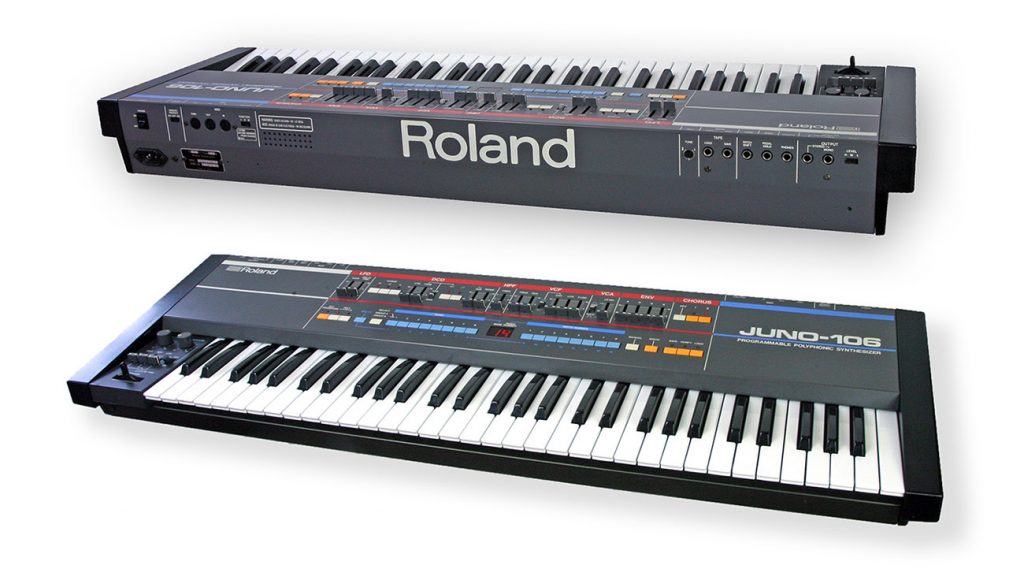
- #Roland juno 106 patches manual
- #Roland juno 106 patches Patch
- #Roland juno 106 patches series
- #Roland juno 106 patches mac
#Roland juno 106 patches mac
when enabled, any SysEx bulk dump manually transmittedįrom an instrument is automatically received and displayedĭisplays all MIDI input and output by portĬollection, Patch, and Bank SysEx files from Mac and Windows Imported SysEx is automatically opened in the appropriate Midi Quest editor mid files - a single file canĬontain SysEx for one or multiple instruments and include
#Roland juno 106 patches manual
Patches from the bank into the editor with manual or autoĪutomatic import of SysEx stored in. Quickly and intelligently create entire banks of unique new sounds With undo history - back out of any editing changes
#Roland juno 106 patches Patch
Patches within the current bank or with other banksĪutomatically auditions the selected patch on the instrument Sensitive virtual keyboard, Smart Thru for external keyboardĪllows chunks of a patch (Oscillator, LFO, Envelopes,Įffects, etc) to be copied and pasted within a patch, or toĭrag and drop interface to copy, paste, or swap Patch auditioning options: pitch and velocity Scale editors to any size (up to 3x standard size)Įditing and experimentation (requires iPad with 2MB+ RAM)

MIDI Quest for iPad allows you to manage theįollowing SysEx from the Juno-106: Patch Bank A, Patch Bank B and Patch.īelow is a sampling of Midi Quest features. Each hasĪ different set of features and in-app purchase options. MidiQuesti, MidiQuestEssentialsi, and MidiQuestLibrariani. There are three versions of Midi Quest available for the iPad: Which are unique to the app such as intelligent patch generators,īlock copy tools, unlimited undo, parent/child patch management, and Midi Quest also offers advanced tools and features Midi Quest includes the basics that should be included inĮvery editor/librarian, integrated storage and editing of both patchĪnd bank SysEx (don't expect bank editors in simple panel editing Sound Quest's 30 year history of creating editor/librarian softwareįor MIDI hardware means that Midi Quest offers the mostĪnywhere. Only editor/librarian to offer fully integrated, studio wide, SysEx With support for over 900 instruments and devices, Midi Quest is the The instrument's settings, and includes unparalleledĮditing, organization, and creative tools to maximize the sonic Midi Quest multi-instrument editor/librarian protects the Juno-106įrom data loss, provides an intuitive graphic interface to display That's the experience I've had compulsively watching eBay & Craigslist for these things over 3-4 months.Įdit - this is relevant to the US market I guess, I don't know how different the European market is.Roland Juno-106 Editor Librarian for Midi Quest iPad Roland Juno-106 Editor Librarian for Mac/Windowsĭeveloped specifically for the Roland Juno-106, Sound Quest's Out of all of these, IMHO the Akai's have the best interfaces, especially the 60 which is basically a Juno 60 interface.
#Roland juno 106 patches series
of the lesser-known analog polys), followed by the Siel DK series which are rare but cheap, followed by Polaris which can be cheap or Juno-priced depending on the auction, then Akai AX60 (VCO) and 80 (DCO) which are less common than Junos but show up on eBay regularly, and finally Alpha Juno and JX-?ps which are easy to find and shockingly cheap without the programmer.

In my experience the Kawai SX is the most rare/expensive (edit. I've been going through the same analog/poly quest as the OP and many others for the past few months (since I registered a screen name here, actually). I don't think that meets the OP's criteria of a "polyphonic analog." But I do love the TAL-UNO 62 Juno emulator software, personally.

Solderman wrote:Am I allowed to suggest software?


 0 kommentar(er)
0 kommentar(er)
